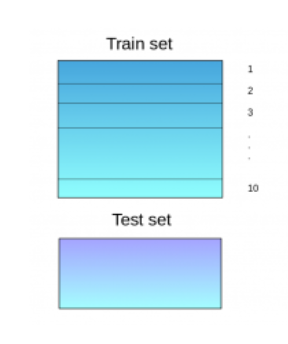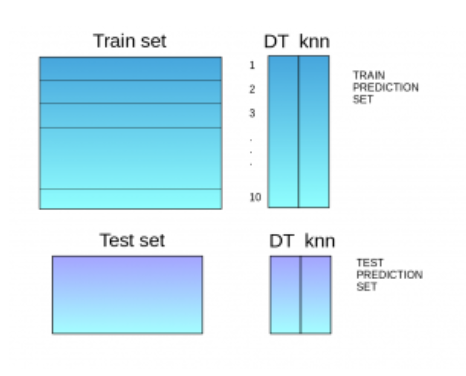1. Introduction
Blending 集成方法的学习过程中,可以发现 Blending 在集成过程中只使用到了验证集的数据,这就造成了很大的浪费。因此可以靠用使用 Stacking 集成方法进行改进。
Blending 产生验证集的方式是使用分割的方式,产生一组训练集和验证集,那么是否可以将这种方式改进为交叉验证的方式呢?于是就有了如下的 Stacking 集成方法,其步骤如下:
- 记初始训练集为
Train set,测试集为Test set,shape 分别为(train_size, 1)和(test_size, 1)。 将Train set划分为多个部分(如 10 个),如下图 (Source: Analytics Vidhya);

- 用划分后的的 9/10 作为训练集 (
train_set) 训练基准模型 (如决策树),并用训练好的模型对剩下的 1/10 数据 (验证集,val_set) 和测试集 (Test_set) 来预测数据; - 重复迭代训练 10 次直到所有数据都作为
val_set,并将val_set的 10 份预测的数据拼接为一个 shape 为 (train_size, 1) 的矩阵 (记为Trainset)。 - 对迭代过程中得到的 10 份测试集 (
Test set) 的预测数据取加权平均,得到一个shape 为 (test_size, 1)的矩阵。 - 重复步骤 2-4 训练其他基准模型 (如 knn) :

- 将上述训练得到的一系列 Trainset 串联,得到一个形状为
(train_size, num_features)的矩阵,并用该矩阵训练第二层的模型,然后用训练好的新模型来做测试集的预测,并作为最终预测结果。
下面借助实例来体验 Stacking 的魅力(参考案例:cnblogs):
注:sklearn 模块并没有 Stacking 的方法,因此需要使用 mlxtend 工具包。
2. A example of stacking model
2.1 Data process
-
Import modules
1
2
3
4
5
6
7
8
9
10
11
12
13
14import numpy as np
import pandas as pd
import matplotlib.pyplot as plt
from sklearn.model_selection import cross_val_score
from sklearn.linear_model import LogisticRegression
from sklearn.neighbors import KNeighborsClassifier
from sklearn.naive_bayes import GaussianNB
from sklearn.ensemble import RandomForestClassifier
from mlxtend.classifier import StackingCVClassifier
from sklearn.metrics import accuracy_score as ac
from sklearn.model_selection import train_test_split
%matplotlib inline -
Load data
本案例使用了Kaggle比赛中的一份泰坦尼克号乘客的数据来进行处理,下载链接:Titanic-data.csv1
data = pd.read_csv('./titanic-data.csv')
Information:
- PassengerId:乘客ID
- Survived:是否获救,用1和Rescued表示获救,用0或者not saved表示没有获救
- Pclass:乘客等级,“1”表示Upper,“2”表示Middle,“3”表示Lower
- Name:乘客姓名
- Sex:性别
- Age:年龄
- SibSp:乘客在船上的配偶数量或兄弟姐妹数量)
- Parch:乘客在船上的父母或子女数量
- Ticket:船票信息
- Fare:票价
- Cabin:是否住在独立的房间,“1”表示是,“0”为否
- embarked:表示乘客上船的码头距离泰坦尼克出发码头的距离,数值越大表示距离越远
-
Statistical description
1
data.info() # See datatype
Results:
1
2
3
4
5
6
7
8
9
10
11
12
13
14
15
16
17
18
19<class 'pandas.core.frame.DataFrame'>
RangeIndex: 891 entries, 0 to 890
Data columns (total 12 columns):
# Column Non-Null Count Dtype
--- ------ -------------- -----
0 PassengerId 891 non-null int64
1 Survived 891 non-null int64
2 Pclass 891 non-null int64
3 Name 891 non-null object
4 Sex 891 non-null object
5 Age 714 non-null float64
6 SibSp 891 non-null int64
7 Parch 891 non-null int64
8 Ticket 891 non-null object
9 Fare 891 non-null float64
10 Cabin 204 non-null object
11 Embarked 889 non-null object
dtypes: float64(2), int64(5), object(5)
memory usage: 83.7+ KB -
Missing values processing
-
Embarked
Embarked 列仅有两个缺失值,而 ‘S’ 占比最高,故将缺失值用 ‘S’ 填充;
1
data['Embarked'] = data['Embarked'].fillna('S')
-
Age
Age 包含较多缺失值,用均值填充;
1
2dmean_age = data['Age'].mean()
data['Age'] = data['Age'].fillna(mean_age) -
Cabin
Cabin 值缺失过多,且每位乘客房间号均不一样,且无规律,故舍去。
-
-
Datatype transformation
-
Sex
将性别转换未数值型数据,用 0 表示男性,1 表示女性1
2data.loc[data['Sex'] == 'male', 'Sex'] = 0 # 'male' -> 0
data.loc[data['Sex'] == 'female', 'Sex'] = 1 # 'female' -> 1 -
Embarked
将 ‘C’ 所在位置的值改为 1, ‘S’ 所在位置的值改为 2, ‘Q’ 所在位置的值改为 3;
1
2
3data.loc[data['Embarked'] == 'C', 'Embarked'] = 1 # 'C' -> 1
data.loc[data['Embarked'] == 'S', 'Embarked'] = 2 # 'S' -> 2
data.loc[data['Embarked'] == 'Q', 'Embarked'] = 3 # 'Q' -> 3 -
Drop irrelevant variables
1
2
3columns = data.columns
columns = columns.drop(['PassengerId', 'Cabin', 'Name', 'Ticket'])
data = data.loc[:, columns]
-
-
Parameters setting
可以直到 data的列名称为['Survived', 'Pclass', 'Sex', 'Age', 'SibSp', 'Parch', 'Fare', 'Embarked']。选择最后一列作为分类标准。1
2
3
4
5
6test_percent = 0.10 # 测试集大小
train_X = train.loc[:, data.columns[1:]]
train_Y = train.loc[:, data.columns[0]].values.reshape(-1,)
test_X = test.loc[:, data.columns[1:]]
test_Y = test.loc[:, data.columns[0]].values.reshape(-1,)
2.2 Creating Stacking model
-
Stacking
1
2
3
4
5
6
7
8
9
10
11
12
13
14
15
16
17
18
19
20
21
22RANDOM_SEED = 42
# The first layer
clf1 = KNeighborsClassifier(n_neighbors=1)
clf2 = RandomForestClassifier(random_state=RANDOM_SEED)
clf3 = GaussianNB()
lr = LogisticRegression()
# Starting from v0.16.0, StackingCVRegressor supports
# `random_state` to get deterministic result.
sclf = StackingCVClassifier(
classifiers=[clf1, clf2, clf3], # The first layer
meta_classifier=lr, # THe second layer
random_state=RANDOM_SEED)
print('3-fold cross validation:\n')
for clf, label in zip([clf1, clf2, clf3, sclf], ['KNN', 'Random Forest', 'Naive Bayes','StackingClassifier']):
scores = cross_val_score(clf, train_X, train_Y,
cv=3, scoring='accuracy')
print("Accuracy: %0.2f (+/- %0.2f) [%s]" % (scores.mean(),
scores.std(), label))Result:
1
2
3
4
5
63-fold cross validation:
Accuracy: 0.70 (+/- 0.02) [KNN]
Accuracy: 0.80 (+/- 0.01) [Random Forest]
Accuracy: 0.76 (+/- 0.02) [Naive Bayes]
Accuracy: 0.79 (+/- 0.01) [StackingClassifier] -
Ploting decision region
由于使用了多维数据,决策边界暂无法成功绘制,有时间了再琢磨。
3. Conclusion
3.1 Blending 和 Stacking 对比
- Blending 优点:
- 比 Stacking 简单,不用进行
K次的交叉验证来获得 stacker feature
- 比 Stacking 简单,不用进行
- 缺点:
- 在训练第二层的模型的时候,仅使用了很少的数据;
- 由于第二层训练数据较少,容易导致过拟合
- stacking 使用多测的 CV 会比较文件。
